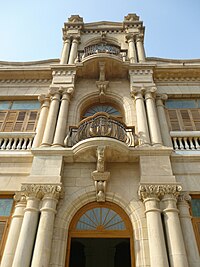Mukhi House
| Mukhi House | |
|---|---|
 | |
 | |
| General information | |
| Address | Hyderabad, Sindh |
| Coordinates | 25°23′10″N 68°22′15″E / 25.3862°N 68.3708°ECoordinates: 25°23′10″N 68°22′15″E / 25.3862°N 68.3708°E |
| Owner | Jethanand Mukhi family (until 1957) |
Mukhi House (Hindi: मुखी भवन), also referred to as Mukhi Mahal(Hindi: मुखी महल), is a museum situated in Hyderabad, Sindh, Pakistan. For a limited time, it served as the Khadija Girls School, a government educational institution.
Historical Background[edit]
Constructed in 1920 by Jethanand Mukhi, the Mukhi House was initially a family residence. However, following the Partition of India, the Mukhi family had to vacate the property by 1957.
After the partition, the ownership of Mukhi House changed hands several times. The original owner intended to gift it to Mir Ali Ahmed, but he declined the offer. Over the years, the house came under the control of the Evacuee Trust Property Board and various governmental organisations, leading to neglect and damage due to misuse and civil unrest. In 2009, the Sindh Antiquities Department began restoration efforts, with the Mukhi family supporting the transformation of the building into a public museum.
Notably, Mukhi House has been visited by prominent figures, including former Indian Prime Minister Jawaharlal Nehru, along with other notable personalities from the Indian subcontinent.
Under the leadership of Kaleemullah Lashari, the restoration team worked closely with the Mukhi family to ensure the accurate revival of the original interior design. In 2020, after significant restoration, Mukhi House was inaugurated as an archaeological museum, showcasing its historical grandeur.
Architectural Features[edit]
The architecture of Mukhi House reflects a fusion of Renaissance, Art Deco, and Art Nouveau styles. It comprises multiple bedrooms, courtyards, halls, and a library. Indian craftsmanship is prominently displayed in the intricate floor designs, wooden accents, and fresco-like stonework. The museum's exhibits, which include family photographs and artifacts, provide insight into the Mukhi family's lavish lifestyle and their influential role in society and politics.